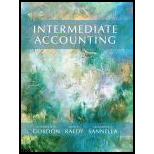
Intermediate Accounting
1st Edition
ISBN: 9780132162302
Author: Elizabeth A. Gordon, Jana S. Raedy, Alexander J. Sannella
Publisher: PEARSON
expand_more
expand_more
format_list_bulleted
Question
Chapter 16, Problem 2BCC
1.
To determine
To state: When entities must make the fair value option election and why the board makes the decision.
2.
To determine
The main concerns expressed by the respondents to the Exposure Draft to the approach and the reason why the FASB decided to allow the instrument-by-instrument approach.
Expert Solution & Answer
Want to see the full answer?
Check out a sample textbook solution
Students have asked these similar questions
I am looking for the correct answer to this general accounting question with appropriate explanations.
Please explain the correct approach for solving this financial accounting question.
Can you explain the correct methodology to solve this general accounting problem?
Chapter 16 Solutions
Intermediate Accounting
Ch. 16 - Prob. 16.1QCh. 16 - Is reporting an investment at its cost considered...Ch. 16 - Prob. 16.3QCh. 16 - Prob. 16.4QCh. 16 - Prob. 16.5QCh. 16 - Prob. 16.6QCh. 16 - What categories can managers use to classify...Ch. 16 - When is the equity method of accounting for...Ch. 16 - Prob. 16.9QCh. 16 - Can companies apply the fair value option to all...
Ch. 16 - What is the fair value hierarchy for investment...Ch. 16 - Prob. 16.12QCh. 16 - Prob. 16.13QCh. 16 - Prob. 16.14QCh. 16 - Prob. 16.15QCh. 16 - Prob. 16.16QCh. 16 - Prob. 16.17QCh. 16 - Deutsch Imports has three securities in its...Ch. 16 - Prob. 16.2MCCh. 16 - Prob. 16.3MCCh. 16 - Prob. 16.4MCCh. 16 - Prob. 16.5MCCh. 16 - Prob. 16.6MCCh. 16 - Prob. 16.7MCCh. 16 - Prob. 16.1BECh. 16 - Prob. 16.2BECh. 16 - Debt Investments, Trading. Using the information...Ch. 16 - Prob. 16.4BECh. 16 - Prob. 16.5BECh. 16 - Prob. 16.6BECh. 16 - Prob. 16.7BECh. 16 - Prob. 16.8BECh. 16 - Notes Receivable. Aaron Anatole accepted a...Ch. 16 - Prob. 16.10BECh. 16 - Prob. 16.11BECh. 16 - Prob. 16.12BECh. 16 - Debt Investments. Impairments. IFRS. For each debt...Ch. 16 - Prob. 16.14BECh. 16 - Prob. 16.15BECh. 16 - Prob. 16.1ECh. 16 - Prob. 16.2ECh. 16 - Prob. 16.3ECh. 16 - Prob. 16.4ECh. 16 - Prob. 16.5ECh. 16 - Prob. 16.6ECh. 16 - Debt and Equity Investments, Available-for-Sale...Ch. 16 - Prob. 16.8ECh. 16 - Prob. 16.9ECh. 16 - Prob. 16.11ECh. 16 - Equity-Investments, Equity Method. Book Value of...Ch. 16 - Prob. 16.13ECh. 16 - Prob. 16.14ECh. 16 - Notes Receivable. Each of the following three...Ch. 16 - Prob. 16.16ECh. 16 - Prob. 16.17ECh. 16 - Prob. 16.18ECh. 16 - Prob. 16.19ECh. 16 - Prob. 16.20ECh. 16 - Prob. 16.21ECh. 16 - Prob. 16.22ECh. 16 - Prob. 16.23ECh. 16 - Prob. 16.1PCh. 16 - Debt Investments, Trading. Freder Software Group...Ch. 16 - Prob. 16.3PCh. 16 - Equity Investments, Readily Determinable Fair...Ch. 16 - Prob. 16.5PCh. 16 - Prob. 16.6PCh. 16 - Prob. 16.7PCh. 16 - Prob. 16.8PCh. 16 - Prob. 16.9PCh. 16 - Equity Investments, Equity Method, Fair Value...Ch. 16 - Prob. 16.11PCh. 16 - Prob. 16.12PCh. 16 - Prob. 16.13PCh. 16 - Prob. 16.14PCh. 16 - Prob. 16.15PCh. 16 - Prob. 16.16PCh. 16 - Prob. 16.17PCh. 16 - Prob. 1JCCh. 16 - Prob. 2JCCh. 16 - Prob. 1FSACCh. 16 - Prob. 1SSCCh. 16 - Prob. 1BCCCh. 16 - Prob. 2BCC
Knowledge Booster
Similar questions
- I need help finding the accurate solution to this general accounting problem with valid methods.arrow_forwardI am searching for the accurate solution to this general accounting problem with the right approach.arrow_forwardI need assistance with this financial accounting question using appropriate principles.arrow_forward
- I need help with this general accounting question using the proper accounting approach.arrow_forwardI am looking for the correct answer to this general accounting question with appropriate explanations.arrow_forwardPlease provide the correct answer to this general accounting problem using accurate calculations.arrow_forward
- Please provide the accurate answer to this general accounting problem using valid techniques.arrow_forwardPlease provide the solution to this financial accounting question using proper accounting principles.arrow_forwardI need help solving this general accounting question with the proper methodology.arrow_forward
- Can you explain this general accounting question using accurate calculation methods?arrow_forwardCan you help me solve this general accounting problem using the correct accounting process?arrow_forwardI need help finding the accurate solution to this financial accounting problem with valid methods.arrow_forward
arrow_back_ios
SEE MORE QUESTIONS
arrow_forward_ios
Recommended textbooks for you

 AccountingAccountingISBN:9781337272094Author:WARREN, Carl S., Reeve, James M., Duchac, Jonathan E.Publisher:Cengage Learning,
AccountingAccountingISBN:9781337272094Author:WARREN, Carl S., Reeve, James M., Duchac, Jonathan E.Publisher:Cengage Learning, Accounting Information SystemsAccountingISBN:9781337619202Author:Hall, James A.Publisher:Cengage Learning,
Accounting Information SystemsAccountingISBN:9781337619202Author:Hall, James A.Publisher:Cengage Learning, Horngren's Cost Accounting: A Managerial Emphasis...AccountingISBN:9780134475585Author:Srikant M. Datar, Madhav V. RajanPublisher:PEARSON
Horngren's Cost Accounting: A Managerial Emphasis...AccountingISBN:9780134475585Author:Srikant M. Datar, Madhav V. RajanPublisher:PEARSON Intermediate AccountingAccountingISBN:9781259722660Author:J. David Spiceland, Mark W. Nelson, Wayne M ThomasPublisher:McGraw-Hill Education
Intermediate AccountingAccountingISBN:9781259722660Author:J. David Spiceland, Mark W. Nelson, Wayne M ThomasPublisher:McGraw-Hill Education Financial and Managerial AccountingAccountingISBN:9781259726705Author:John J Wild, Ken W. Shaw, Barbara Chiappetta Fundamental Accounting PrinciplesPublisher:McGraw-Hill Education
Financial and Managerial AccountingAccountingISBN:9781259726705Author:John J Wild, Ken W. Shaw, Barbara Chiappetta Fundamental Accounting PrinciplesPublisher:McGraw-Hill Education


Accounting
Accounting
ISBN:9781337272094
Author:WARREN, Carl S., Reeve, James M., Duchac, Jonathan E.
Publisher:Cengage Learning,

Accounting Information Systems
Accounting
ISBN:9781337619202
Author:Hall, James A.
Publisher:Cengage Learning,

Horngren's Cost Accounting: A Managerial Emphasis...
Accounting
ISBN:9780134475585
Author:Srikant M. Datar, Madhav V. Rajan
Publisher:PEARSON

Intermediate Accounting
Accounting
ISBN:9781259722660
Author:J. David Spiceland, Mark W. Nelson, Wayne M Thomas
Publisher:McGraw-Hill Education

Financial and Managerial Accounting
Accounting
ISBN:9781259726705
Author:John J Wild, Ken W. Shaw, Barbara Chiappetta Fundamental Accounting Principles
Publisher:McGraw-Hill Education